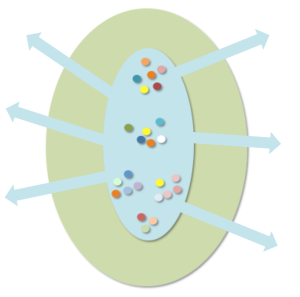*for a definition of WIL and some initial discussions around why I think we need to reinvent it, see my blog post from last week
I have argued elsewhere that in the real value in learning that the future university will provide students is not so much in the manifest curriculum content, apart from what we can offer through bespoke knowledge creation (research). Instead, what differentiates institutions will be the quality of the learning experiences we provide, and the industry/community networks we can offer. Creative faculties therefore need to start investing strongly in building relationships with industry and community, and fostering teacher capacity to teach creative enterprise as well as the capabilities associated with disciplinary practice. All three of the WIL models I propose below are predicated upon these investments, and also upon offering far more significant WIL provision than a single capstone 14-week experience. Actually, what I think I’m suggesting here is that these models could form the central learning experiences in a course.
(1) Offer internships with big, non-creative sector industry partners.
 Here I borrow a little from successful Business School models of WIL, where the Faculty partners with big players (e.g., Deloitte or Ernst & Young) to offer a significant number of WIL opportunities each semester. The industry partner knows that by offering these internships that they have a direct recruitment pipeline to the best talent the university has to offer; in turn, the students get a high profile industry-based learning experience.
Here I borrow a little from successful Business School models of WIL, where the Faculty partners with big players (e.g., Deloitte or Ernst & Young) to offer a significant number of WIL opportunities each semester. The industry partner knows that by offering these internships that they have a direct recruitment pipeline to the best talent the university has to offer; in turn, the students get a high profile industry-based learning experience.
Where the creative internship model I propose differs from the Business School approach is that the creative students are embedded in non-cognate organisations. The Business School model involves, for instance, accountancy students heading over to Ernst and Young to work with other accountants on auditing, tax, and risk assessment. The creative faculty could, by contrast, partner with a very large firm (such as Westfield Group, Woolworths or Telstra in Australia), and send arts/graphic design, interactive and visual design, media and communications, interior design, and media production students to different areas of the firm for internships. As well as offering a pipeline for recruitment, the embedding of creative students into the organisation has the potential to increase the innovation capacity of the partner firm if it’s done right (Hearn & Bridgstock, 2014), as well as offering a relevant and enriching work integrated learning experience for creative students, who are quite likely to end up working in embedded roles in the future. The students experiencing this type of internship learn intrapreneurship, and how to work effectively with, and for, people who don’t come from their home creative discipline.
(2) Micro business and enterprise development.
We know that creative people are more likely than not to be self-employed to some extent. Most often, it’s als o in these small ‘micro enterprise’ / start up situations where really innovative work goes on, rather than big (risk averse) firms. Micro-enterprise is becoming a much more common business model generally, through the growth of the sharing economy and ‘uberisation’ of professional services. However, many creative students do not regard themselves as entrepreneurial, and the majority of creative schools don’t teach for micro-enterprise development at all.
o in these small ‘micro enterprise’ / start up situations where really innovative work goes on, rather than big (risk averse) firms. Micro-enterprise is becoming a much more common business model generally, through the growth of the sharing economy and ‘uberisation’ of professional services. However, many creative students do not regard themselves as entrepreneurial, and the majority of creative schools don’t teach for micro-enterprise development at all.
There is significant precedent for micro-creative enterprise learning in higher education, though (see, for instance, Rae 2012, or for diverse disciplines Culkin 2013), most often via coaching and mentoring, ideation, incubation and accelareration services, networking and resourcing support. In my own university, and co-located with the Faculty, we have a well-established creative incubator/accelerator, the only of its kind in the country, Creative Enterprise Australia. They offer a full range of startup support services, but there is actually very little overlap between their commercial activities and the faculty’s teaching.
Not all creative students will start their own businesses after graduation, but these learning opportunities are possibly the most effective way of developing true enterprise and entrepreneurship capabilities, disciplinary agility and students’ professional networks.
(3) Adopt a ‘teaching hospital’ model.
 Neither of the previous two models represents a radical departure from what various universities have attempted previously, although they aren’t part of mainsteam teaching practice. Unfortunately, WIL tends to be highly time and resource intensive, and this means that creative faculties have trouble sustaining these kinds of experiments beyond special funded projects. This is where the third model comes in.
Neither of the previous two models represents a radical departure from what various universities have attempted previously, although they aren’t part of mainsteam teaching practice. Unfortunately, WIL tends to be highly time and resource intensive, and this means that creative faculties have trouble sustaining these kinds of experiments beyond special funded projects. This is where the third model comes in.
The third model involves embedding a creative enterprise into the heart of the creative faculty. This enterprise would provide commercial bundled creative products and services across art and design, digital, marketing, media/communications, performative and professional writing fields. In line with the key areas of growth in the creative economy, these products and services would target the Business-to-Business (B2B) market, but also would be able to support student micro-business development (model 2) and placements directly into non-creative firms (model 1) within it. The creative ‘teaching hospital’ should also encompass a non-profit arm, to support community engagement and social enterprise endeavours. It could support interdiscipinary collaborations with students and staff from other faculties.
In model 3 students learn through increasingly complex enterprise practice, supported and facilitated by academic and industry staff, and through legitimate peripheral participation models. This model has some resemblence to Vocational Education and Training models where, for instance, hospitality students learn through working at the institution’s cafe/restaurant. However, the key difference is in the capability types and complexity, the degree of criticality, theory and other contexualisation, and the emphasis on reflective professional practice. Students also end the program able to cite high level practice, real project outcomes and real clients. I’ve talked more about how learning in this model would work in my paper Educating for digital futures (Bridgstock, 2014).
Model 3 is the most risky of the three, but also has the most potential to yield big results. It requires redesigning the creative faculty around creative enterprise, including hiring industry practitioners and resourcing industry-ready practice. It also involves a radical change in curriculum and pedagogic practice for academic staff. There are also numerous ways that the teaching hospital model doesn’t fit within existing university structures (physical, procedural and policy). Some of these challenges may be surmounted by placing the enterprise to one side of the faculty rather than within it, with the university accrediting and providing qualifications on the basis of the learning experiences offered by the enterprise.
Yes, this is all a bit ‘out there’. I think it’s also the best way to build enriching, relevant learning experiences for creative students who are seeking employment outcomes (and to make a contribution to society and the economy). These models are also very different from mainstream practice in universities, and they have the potential to be highly marketable. In the case of models 2 and 3, there are revenue generation possibilities for the faculty in these models as well.
References
Bridgstock, R. (2014). Educating for digital futures: what the learning strategies of digital media professionals can teach higher education. Innovations in Education and Teaching International, (ahead-of-print), 1-10.
Culkin, N. (2013). Beyond being a student: An exploration of student and graduate start-ups (SGSUs) operating from university incubators. Journal of Small Business and Enterprise Development, 20(3), 634-649.
Lave, J., & Wenger, E. (1991). Situated learning: Legitimate peripheral participation. Cambridge University Press, Cambridge.
Rae, D. (2012). Action learning in new creative ventures. International Journal of Entrepreneurial Behavior & Research, 18(5), 603-623.
